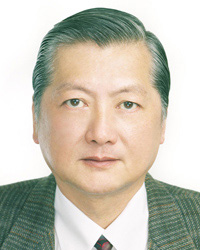許博文 Powen Hsu
國立台灣大學電信工程學研究所 特聘教授
國立台灣大學光電工程學研究所 特聘教授
Distinguished Professor, Graduate Institute of Communication Engineering, National Taiwan University
Distinguished Professor, Graduate Institute of Photonics and Optoelectronics, National Taiwan University
主要研究領域:
天線、微波及毫米波電路Major Research Areas:
Antennas, Microwave and Millimeter Wave Circuits研究領域摘要:
縮小化及諧波抑制是無線通訊系統中天線設計的兩個重要課題。縮小化之所以重要,是因為絕大多數無線手持裝置留給擺置天線的面積通常都很小。諧波抑制之所以重要,是因為它能降低天線諧振波模態中儲存的功率,因而減少收發器內電路間的電磁干擾。本計畫將使用L-型金屬帶線來對共面波導饋入開槽偶極天線從事縮小化或諧波抑制。本方法極為簡單,並不需要外加任何元、組件或增加一層介質或金屬層。我們的初步數值模擬結果顯示,適當地選擇L-型帶線在開槽內的擺放位置,天線的大小可以被縮減或者其諧振波可以被抑制。雖然如此,但是本方法的工作原理、最佳化設計、以及實驗驗證仍有待進行,而這些項目正是提出本研究計畫的目的。
Research Summary:
Miniaturization and harmonic suppression are two important issues in the design of antennas for wireless communication systems. Miniaturization is important, since in most wireless handheld devices, the area left for placing the antenna is usually small. Harmonic suppression is also important, since it can lower the power in the harmonic modes of the antenna and hence reduce the electromagnetic interference within the transceiver circuitry. L-shaped metal strips will be used in this project to reduce the size and/or suppress the harmonics of the coplanar waveguide-fed slot dipole antenna. The method is simple, and no additional component/device or extra substrate/metal layer is needed. Our preliminary simulation results show that by properly placing the L-shaped strip inside the slot, the antenna can either be reduced in size or its harmonics be suppressed. However, the theory behind the operation and the optimization and experimental verification of the design are still needed to be carried out. These are the purposes of this research project.

-
B.S.
Physics, National Tsing-Hua University, 1972 -
M.S.
EE, University of Southern California, 1978 -
Ph.D.
EE, University of Southern California, 1982 - M.S., Physics, University of Maryland, 1976
-
Address
EE2-544,
Department of Electrical Engineering,
National Taiwan University,
Taipei 106, Taiwan -
Phone
+886-2-33663654 -
FAX
+886-2-23651744 -
Email:

-
Office Hour
Tue. 15:30~16:30, Wed. 15:00~16:00